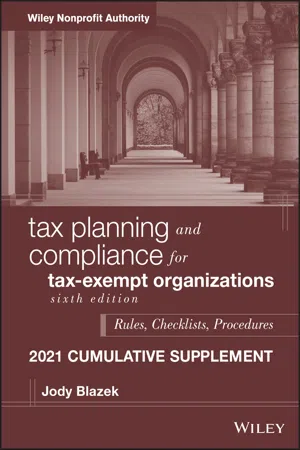
Tax Planning and Compliance for Tax-Exempt Organizations
Rules, Checklists, Procedures, 2021 Supplement
Jody Blazek
- English
- ePUB (mobile friendly)
- Available on iOS & Android
Tax Planning and Compliance for Tax-Exempt Organizations
Rules, Checklists, Procedures, 2021 Supplement
Jody Blazek
About This Book
Stay informed about the latest legislative, regulatory, and case law developments in the area of tax-exempt organization taxation and compliance In the 2021 Supplement to the 6th edition of Tax Planning and Compliance for Tax-Exempt Organizations: Rules, Checklists, Procedures, readers will find authoritative guidance and insightful commentary on the latest regulatory and legislative changes affecting public charities, private foundations, civic associations, business leagues, and social clubs. The Supplement also includes comprehensive coverage of the most important cases and common law developments governing tax-exempt organizations, the managers who oversee them, and the professionals who advise them. Written by one of the leading authorities in the field, this latest update to a complex and rapidly evolving area of the law is an indispensable and reliable companion to the most recent edition of Tax Planning and Compliance for Tax-Exempt Organizations.
Frequently asked questions
Information
PART I
Qualifications of Tax‐Exempt Organizations
- Chapter 1
- Distinguishing Characteristics of Tax‐Exempt Organizations
- Chapter 2
- Qualifying Under IRC § 501(c)(3)
- Chapter 3
- Religious Organizations
- Chapter 4
- Charitable Organizations
- Chapter 5
- Educational, Scientific, and Literary Purposes and Prevention of Cruelty to Children and Animals
- Chapter 6
- Civic Leagues and Local Associations of Employees: § 501(c)(4)
- Chapter 9
- Social Clubs: § 501(c)(7)
- Chapter 11
- Public Charities
CHAPTER 1
Distinguishing Characteristics of Tax‐Exempt Organizations
- § 1.8 Developments Responding to COVID‐19
- (a) CARES and SECURE Acts
- (b) IRS Delays in Tax Payment and Return Due Dates
§ 1.8 Developments Responding to COVID‐19
(a) CARES and SECURE Acts
- Up to $300 of charitable cash contributions can be taken as a deduction against adjusted gross income (AGI), regardless of whether or not the individual itemizes.
- For 2020, the 50 percent AGI limitation was eliminated, and individuals got a charitable contribution deduction for up to 100 percent of a person's AGI, for cash (not appreciated property) contributions.
- Employers receive a credit for their portion of the payroll tax (7.65 percent) up to $10,000 of wages per employee if the business has been impacted by COVID‐19 or if revenue is 50 percent lower than the same quarter in 2019.
- Payment of the 2020 payroll tax can be delayed; with 50 percent of the payroll tax due paid in 2021 and 50 percent in 2022.
- Economic Injury Disaster Loans (EIDL): business loans for up to $2 million at an annual interest rate of 3.75 percent, with the first payment not due for one full year. If you apply for an EIDL loan, you can also apply for a $10,000 grant toward working capital. These loans can be used to pay and retain employees, make lease payments, pay operating costs, and so forth.
- Small business owners may qualify for tax‐free loan forgiveness for the portion of the loan between March 1 and June 30. It could be forgiven if the funds are used to maintain payroll.
- The Act suspends all rules that relate to the Net Operating Losses (NOL) created under the 2017 Tax Cuts and Jobs Act (TCJA). Under the TCJA, NOLs were limited to 80 percent of taxable income and could not be carried back. NOLs can now be carried back up to five tax years with no income limit.
- Loss limitations that were imposed under the TCJA have been suspended: $250,000 for single and $500,000 for joint filings. These losses can offset nonbusiness income.
- Business interest deductibility has been increased from 30 percent of adjusted taxable income to 50 percent.